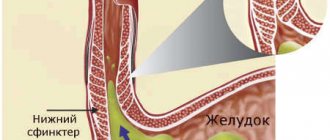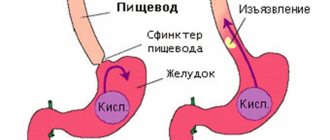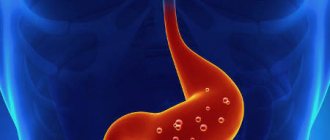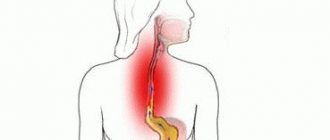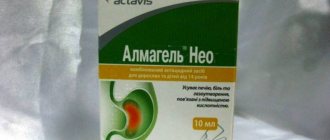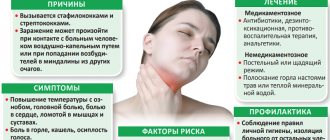Degrees of pathology
The first (“A”) degree of the disease discussed in the article is characterized by the development of hyperemia of the esophageal mucosa and the appearance of local erosions on it. Their diameter usually does not exceed five millimeters. Manifestations of grade A reflux esophagitis are usually absent or mildly expressed. A person usually does not consult a doctor or does so when the disease has progressed to the next stages.
The further course of the pathology looks like this.
- With the second degree, significantly more defective zones are observed, and they begin to merge. They do not cover the entire surface of the esophagus.
- In the third degree of development of the disease, the ulcerative lesion covers a significant part of the esophagus. The symptoms are clearly defined.
- When the fourth stage occurs, almost the entire mucous membrane can be affected. It is difficult for a person to swallow, and the pain is constant and does not depend on food intake.
Note! This stage of the pathology is the most severe and dangerous, because it can cause acute narrowing of the lumen of the esophagus, and sometimes cancer.
Types of reflux esophagitis
There are two main forms of pathology of the esophageal mucosa.
- Acute esophagitis develops against the background of various pathologies of the stomach. Most often it is caused by gastritis, ulcers, and other functional disorders of the gastrointestinal tract. Acute esophagitis is most often located in the lower part of the esophagus. It may also develop as a result of the pathological activity of Helicobacter. If a person develops signs of acute esophagitis, the symptoms manifest themselves in the form of malaise and pain in the chest cavity.
- Chronic reflux esophagitis occurs as a complication of acute reflux. It often develops as a primary disease against the background of prolonged consumption of alcoholic beverages and smoking. An exacerbation causes a clearly defined picture of the disease in the patient.
Depending on the nature of painful lesions in the esophageal mucosa, the following types of pathology are distinguished:
- Superficial, or catarrhal, occurs due to mechanical damage to the organ.
- The exfoliative type is very dangerous because fibrin flakes are separated from the mucosa. The patient develops a severe cough, very intense pain, hemorrhages, and in severe cases, perforation of the walls may occur. Erythematous reflux is similar.
- In the edematous form of the pathology, the mucous membrane swells, causing the diameter of the organ to decrease.
- With erosive reflux esophagitis, an ulcerative process develops. The affected areas swell, leading to the development of cysts.
Interesting! Features of gastroesophageal reflux: symptoms and treatment
- Pseudomembranous type of disease - a fibrin film forms on the surface of the mucosa. When it is rejected, extensive ulcers appear.
- Necrotizing esophagitis is dangerous for the patient because it is a precancerous disease. Often develops with progressive renal failure and immune pathology.
- The phlegmonous process occurs with the release of a huge amount of pus. Damage to neighboring organs is possible.
- Radiation esophagitis can develop as a severe complication of antitumor therapy. Moreover, symptoms of digestive tract dysfunction are observed in the patient for a long time after completion of the radiation exposure.
Causes
Chronic esophagitis develops for the following reasons:
- significant weakness of the muscles of the lower esophageal sphincter;
- relaxation of the sphincter that occurs involuntarily;
- diaphragmatic hernia;
- use of large amounts of antispasmodic and sedative drugs;
- decreased ability of the esophagus to cleanse;
- aggressive effect on the mucous membrane of hydrochloric acid (one of the serious reasons why erosive reflux esophagitis develops);
- decreased local immunity, due to which the mucous membrane cannot resist damaging
- the action of hydrochloric acid;
- disorder of the processes of movement of stomach contents into the duodenum;
- increased pressure inside the abdominal cavity (this occurs with overeating, dropsy, severe flatulence).
Provoking factors for the development of the disease:
- the patient is overweight;
- drinking large amounts of strong alcoholic drinks;
- engaging in intense physical labor;
- gastronomic excesses, dietary errors (for example, non-compliance with food intake);
- prolonged stress;
- wearing a tight belt;
- long-term untreated constipation;
- scleroderma.
Folk remedies
As an auxiliary therapy against catarrhal esophagitis, folk recipes are used that are aimed at improving local immunity. Particularly effective:
- sea buckthorn oil;
- potato juice;
- biogenic stimulant - "Solcoseryl".
A special place is occupied by decoctions of medicinal herbs:
- Collection: chamomile, flaxseed (50 g each), motherwort, licorice rhizome, lemon balm (25 g each), pour 200 ml of boiling water and soak for 10 minutes in a water bath. After settling for 4 hours, drink 75 ml 4 times a day. The drink relieves pain and inflammation, reduces acidity.
- Collection: equal quantities of calamus root, oregano, calendula, anise, damselfish, fireweed, mint. Pour 50 g of the crushed composition with warm water and after 2 hours place in a water bath for 20 minutes. Drink 100 ml 6 times a day after 1 hour. The last dose is at night.
- Collection: equal amounts of plantain, chamomile, dandelion, knotweed rhizome, shepherd's purse, oregano, yarrow. Pour boiling water over 50 g of the collection and drink up to 6 times a day.
- Dill infusion: 2 tsp. pour 250 ml of boiling water over the ground seeds, leave for 6 hours and drink up to 4 times a day. 25 ml before the start of the meal.
Symptoms
Symptoms of grade A reflux esophagitis are as follows:
- burning sensation throughout the esophagus;
- belching with sour contents or air;
- the appearance of a sharp unpleasant odor from the mouth;
- development of inflammatory processes in the mouth, caries;
- the appearance of pain similar to angina pectoris.
With chronic damage, symptoms such as:
- painful cough not accompanied by sputum production;
- change in voice - it becomes hoarse and hoarse;
- constant feeling as if there is a lump in the throat;
- the appearance of painful sensations in the facial area;
- nasal congestion.
Remember! These symptoms may be signs of other gastrointestinal pathologies. A person cannot independently determine whether he has such a disease or not. If signs of damage to the esophagus appear, you should immediately contact a diagnostic center.
How to eliminate grade A reflux
At this stage of esophagitis, special drug treatment is not required. It is enough for a person to follow the rules of nutrition, give up bad habits, and normalize the work and rest schedule in order to bring the activity of the esophagus and stomach back to normal.
Interesting! Treatment with folk remedies for gastroesophageal reflux disease
The phenomenon of reflux esophagitis “A” degree can be eliminated in the following ways:
- stop overeating, eat only small portions;
- do not eat cold or too hot food;
- In order for the symptoms of reflux esophagitis grade A to go away, it is enough to moderate the amount of pickled, fatty and salty foods;
- do not drink beer and other alcoholic beverages that can cause reflux esophagitis grade A;
- eat no later than two hours before bedtime;
- weight normalization will help overcome the manifestations of grade A reflux esophagitis;
- do not wear tight and uncomfortable clothes, especially tight belts that compress the abdominal cavity;
- do not bend over after eating;
- do not take medications that can cause relaxation of the esophageal sphincter and, accordingly, symptoms of reflux esophagitis grade A;
- take vitamins to strengthen the gastrointestinal tract;
- limit the consumption of table salt;
- treat constipation (and it is not necessary to use medications - for this there are a large number of products that help normalize stool).
To treat the initial stages of reflux esophagitis, syrup made from dandelion flowers helps. In order for it to have the necessary therapeutic effect, you should take one teaspoon, diluted in half a glass of water, three times a day.
Important! If the course of the disease worsens, you should consult a doctor. He will prescribe medications, because treatment with folk remedies alone is no longer sufficient.
If a person has developed the first stage of reflux esophagitis, this does not mean that it does not need to be treated. Without therapy, it can progress. In some cases, life-threatening conditions can develop.
Treatment
First of all, it is necessary to relieve acute symptoms of pain, heartburn, and irritation of the esophagus.
To do this, use antacids (acid-reducing), painkillers, and drugs that normalize the motility of the stomach and esophagus. Then you need to follow a diet and nutrition regimen . The temperature of the food eaten should not be too high or too low; an average temperature slightly above average is considered optimal. You need to eat small portions with 1.5-2 hour intervals between meals.
To reduce the secretion of gastric juice, ranitidine, famotidine and other drugs that block histamine receptors are used. Additionally, omeprazole and pantoprozole should be prescribed. The duration of the course of treatment depends on the effectiveness of the chosen regimen, but usually you should be prepared for long-term use: at least six months to a year .
In case of persistent lack of effect from treatment or significant improvement, you can resort to surgical correction of the sphincter of the gastric inlet.
Atrophic esophagitis
Atrophic esophagitis is a chronic inflammatory disease of the esophagus, characterized by tissue degeneration. Doctors often deal with malignant degeneration of an organ. The set of atrophic variants of the pathology is united under the term Barrett's esophagus.
Interesting! Symptoms and treatment of duodenogastric reflux (DGR) of the stomach
The reasons why Barrett's esophagus forms are as follows:
- long-term and untreated inflammatory processes in the esophagus;
- burns of the esophagus due to strong alcoholic drinks, organic and inorganic acids;
- diabetes;
- other chronic pathologies.
Barrett's esophagus is not amenable to conservative treatment. All previously detected pathological areas are cauterized and then removed. If a person is diagnosed with Barrett's esophagus, they should begin treatment as soon as possible. Correction of the diet with the complete exclusion of alcohol is mandatory. The patient is strictly prohibited from smoking.
Diagnostics
To confirm the diagnosis, the patient must undergo the following diagnostic tests:
- X-ray (a contrast agent is used to better visualize the processes occurring in the esophagus and stomach). Using a contrast agent, you can accurately determine the presence of chyme reflux and detect a hernia.
- A study of changes in gastric pH assesses the incidence of intestinal reflux.
- Endoscopy is used to determine the condition of the mucous membrane. An endoscope can be used to take a sample of organ tissue for biopsy.
Diagnostic features
If symptoms of distal reflux esophagitis appear, you should contact a gastroenterologist. The specialist will interview the patient, identify the causes of the disease and conduct an examination. Then the doctor will conduct a differential diagnosis with other pathologies of the esophagus and refer you to special informative diagnostic techniques. These include methods:
- general blood and urine tests;
- blood biochemistry;
- X-ray examination;
- endoscopy;
- intraesophageal pH-metry;
- CT;
- MRI.

